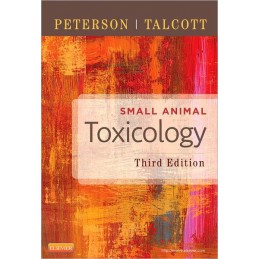- Reduced price

Order to parcel locker

easy pay


 Delivery policy
Delivery policy
Choose Paczkomat Inpost, Orlen Paczka, DHL, DPD or Poczta Polska. Click for more details
 Security policy
Security policy
Pay with a quick bank transfer, payment card or cash on delivery. Click for more details
 Return policy
Return policy
If you are a consumer, you can return the goods within 14 days. Click for more details
Diagnose and determine treatment for toxic exposures in small animals with this quick reference! Small Animal Toxicology, 3rd Edition covers hundreds of potentially toxic substances, providing the information you need to manage emergency treatment and prevent poisonings in companion animals. To help you identify an unknown poison, this guide provides a list of potential toxins based on clinical signs or symptoms. It also includes a NEW color insert with 85 full-color photographs of toxic plants and of lesions associated with various poisonings. Written by respected veterinarian Michael E. Peterson and board-certified veterinary toxicologist Patricia A. Talcott, along with a team of expert contributors, this edition covers a wide variety of topics including toxicodynamics, toxicokinetics, effective history taking, recognizing clinical signs of toxic exposures, managing emergencies, and supportive care of the poisoned patient.
Data sheet
Section 1: Toxicological Concepts
1. General Toxicological Concepts
2. Toxicokinetics and Toxicodynamics
3. Toxicologic Information Resources
4. Effective Use of Veterinary Poison Center NEW!
5. Effective Use of Human Poison Center
6. Taking a Toxicologic History
7. Approach to Diagnosis and Initial Treatment
8. Selecting a Minimum Database
9. Initial Management of the Poisoned Patient
10. Decontamination
11. General Supportive Care
12. Effective Use of the Diagnostic Lab
Section 2: General Exposures
13. Litigation and Toxicology NEW!
14. Indoor Environmental Quality and Health
15. Responding to Mass Exposures NEW!
16. Reproductive Toxicology of the Male and Female
17. Considerations in the Poisoned Pregnant and Lactating Patient
18. Considerations in the Pediatric Poisoned Patient NEW!
19. Considerations in the Geriatric Poisoned Patient NEW!
20. Poisoning in the Captive Reptile
21. Poisoning in the Small Mammal (pocket pets) NEW!
22. Poisoning in the Avian Patient NEW!
Section 3: Miscellaneous Toxicant Groups
23. Adverse Drug Reactions
24. Miscellaneous Indoor Toxicants
25. Recreational Drugs
26. Herbal and Natural Products (homeopathic)
27. Household and Garden Plants
28. Miscellaneous Herbicides, Fungicides, and Nematocides
29. Smoke Inhalation (house fires)
30. Acetaminophen
31. Amitraz
32. Anticoagulant Rodenticides
33. Anticonvulsants
34. Arsenic
35. Botulism
36. Bromethalin
37. Carbon Monoxide
38. Cholecalciferol
39. Christmas time Plants
40. Citrus Oils
41. Copper
42. Cyanide
43. Cyanobacteria
44. DEET
45. Diethylene Glycol
46. Ethanol
47. Ethylene Glycol
48. Grapes and Raisins
49. Insects - Hymenoptera
50. Ionophores
51. Iron
52. Ivermectin: Macrolide Antiparasitic Agents
53. Lead
54. Lilies
55. Poisonous Lizards
56. Macadamia Nuts
57. Mercury
58. Metaldehyde
59. Methanol
60. Methylxanthines
61. Metronidazole
62. Mushrooms
63. Mycotoxins
64. Nicotine
65. Nonsteroidal Antiinflammatories
66. Organochlorine Pesticides
67. Organophosphate and Carbamate Pesticides
68. Oxalate-Containing Plants
69. Paraquat
70. Atypical Topical Spot-On Products
71. Petroleum Hydrocarbons
72. Propylene Glycol
73. Pyrethrins and Pyrethroids
74. Ricin
75. Snake Bite - North American Pit Vipers
76. Snake Bite - Coral Snakes
77. Sodium
78. Sodium Monofluoroacetate
79. Spider Envenomation - Black Widow
80. Spider Envenomation - Brown Recluse
81. Strychnine
82. Toads
83. Xylitol NEW!
84. Zinc
85. Zinc Phosphide
Reference: 36757
Author: Edward C. Feldman
Text with Continually Updated Online Reference, 2-Volume Set
